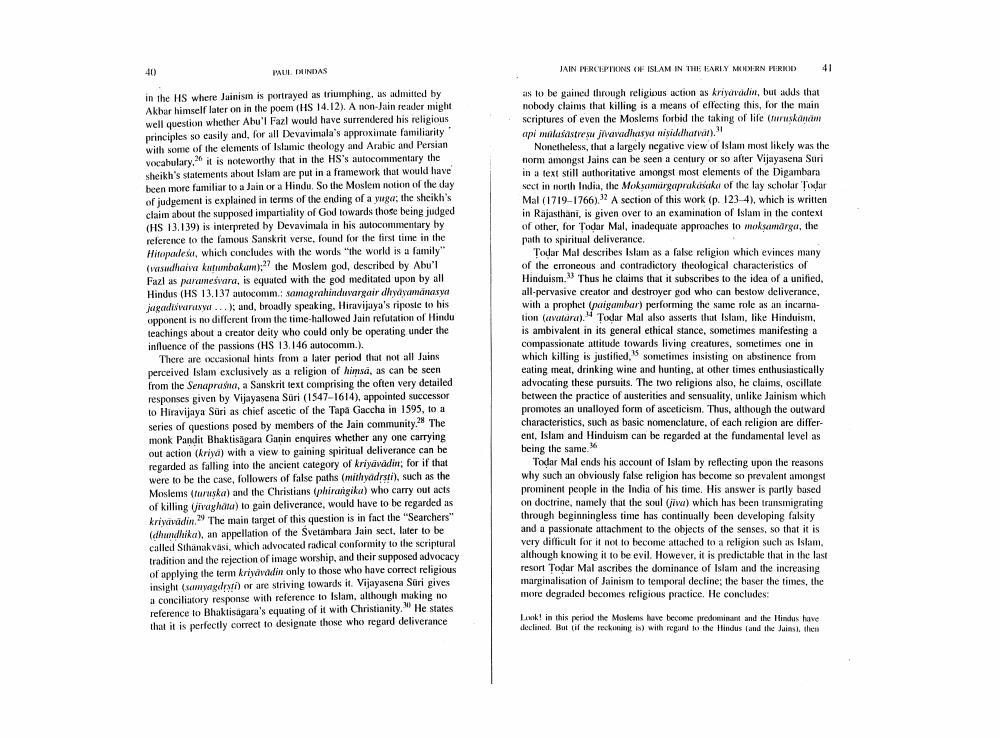________________
MULTINDAS
JAIN PERCEPTIONS <W ISLAM IN TIRKAKIY MNYEN HERMID
41
in the HS where Jainism is portrayed as triumphing, as admitted by Akbar himself later on in the poem (HS 14.12). A non-Jain reader might well question whether Abu'l Fazl would have surrendered his religious principles so easily and for all Devavimala's approximate familiarity with some of the elements of Islamic theology and Arabic and Persian vocabulary, it is noteworthy that in the HS's autocommentary the sheikh's statements about Islam are put in a framework that would have been more familiar to a Jain or a Hindu. So the Moslem notion of the day of judgement is explained in terms of the ending of a yugur, the sheikh's claim about the supposed impartiality of God towards those being judged (HS 13.139) is interpreted by Devavimala in his aut commentary by reference to the famous Sanskrit verse, found for the first time in the Hitopadles, which concludes with the words the world is a family (vasudha kambakant: the Moslem god, described by Abu'l Fazl as purameswara, is equaled with the god meditated upon by all Hindus (HS 13.137 autocomm.: samagrahindwargair dhumainasya jugaderia... and, broadly speaking, Hiravijaya's riposte to his opponent is no different from the time hallowed Jain refutation of Hindu teachings about a creator deity who could only be operating under the influence of the passions (HS 13.146 autocomm.).
There are exccasional hints from a later period that not all Jains perceived Islam exclusively as a religion of himsd, as can be seen from the Senaprasna, a Sanskrit text comprising the often very detailed responses given by Vijayasena Suri (1547-1614), appointed successor to Hiravijaya Suri as chief ascetic of the Tapa Gaccha in 1595, to a series of questions posed by members of the Jain community. The monk Pandit Bhaktisagara Ganin enquires whether any one carrying out action (kriya) with a view to gaining spiritual deliverance can be regarded as falling into the ancient category of kriyavadin; for if that were to be the case, followers of false paths (mithyadrsti), such as the Moslems (furuska) and the Christiansyahirangika) who carry out acts of killing jiraghata) to gain deliverance, would have to be regarded as kriyavadin. The main target of this question is in fact the "Searchers (chudhuika), an appellation of the Svetambara Jain sect, later to be called Sthanakvasi, which advocated radical conformity to the scriptural tradition and the rejection of image worship, and their supposed advocacy of applying the term kriyd in only to those who have correct religious insight (sanyagt) or are striving towards it. Vijayasena Süri gives a conciliatory response with reference to Islam, although making no reference to Bhaktisagara's equating of it with Christianity. He states that it is perfectly correct to designate those who regard deliverance
as to be gained through religious action as kriyavadin, but adds that nobody claims that killing is a means of effecting this, for the main scriptures of even the Moslems forbid the taking of life (ruskanom api ulasastresu javdhaswa ni siddhari)."
Nonetheless, that a largely negative view of Islam most likely was the norm amongst Jains can be seen a century or so after Vijayasena Suri in a text still authoritative amongst most elements of the Digambara sect in north India, the Moksmirgapraketsaka of the lay scholar Todar Mal (1719-1766)." A section of this work (p. 123-4), which is written in Rajasthani, is given over to an examination of Islam in the context of other, for Todar Mal, inadequate approaches to mokamarga, the path to spiritual deliverance.
Todar Mal describes Islam as a false religion which evinces many of the crroneous and contradictory theological characteristics of Hinduism. Thus he claims that it subscribe to the idea of a unified, all-pervasive creator and destroyer god who can bestow deliverance, with a prophet (puigambar) performing the same role as an incarnalion (avuturu)." Toxdur Mal also asserts that Islam, like Hinduism, is ambivalent in its general ethical stance, sometimes manifesting a compassionate attitude towards living creatures, sometimes one in which killing is justified sometimes insisting on abstinence from eating meat, drinking wine and hunting, at other times enthusiastically advocating these pursuits. The two religions also, he claims, oscillate between the practice of austerities and sensuality, unlike Jainism which promotes an unalloyed form of asceticism. Thus, although the outward characteristics, such as basic nomenclature, of each religion are different, Islam and Hinduism can be regarded at the fundamental level as being the same.
Todar Mal ends his account of Islam by reflecting upon the reasons why such an obviously false religion has become so prevalent amongst prominent people in the India of his time. His answer is partly based on doctrine, namely that the soul (five) which has been transmigrating through beginningless time has continually been developing falsity and a passionate attachment to the objects of the senses, so that it is very difficult for it not to become attached to a religion such as Islam, although knowing it to be evil. However, it is predictable that in the last resort Todar Mal ascribes the dominance of Islam and the increasing marginalisation of Jainism to temporal decline; the baser the times, the more degraded becomes religious practice. He concludes:
Lok! in this per the Markens huve become produint and the Hindus have declinel. But if the rec y ) with regard to the lines and the Juins, the




